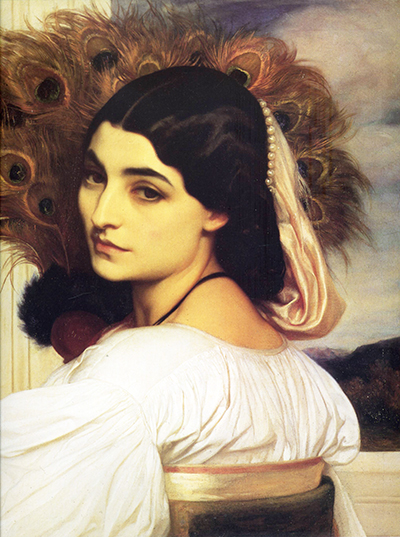Painted in 1859, Pavonia by Sir Frederic Leighton is an oil painting on canvas. This portrait painting has a size of 53 by 41.5 centimetres. The woman in the painting is Nanna Risi, who was the wife of a cobbler but later became a model. The model is dressed a white in flowing fabric and is positioned beside peacock feathers in the background.
Leighton worked with thus model on many occasions after he returned to Rome. The image portrays beauty with the woman compared to a peacock (Pavonia in Italian). This painting is related to another painting that Leighton did three years later. The painting Bianca has the radiance of a dove which seems like an intention to represent a style of beauty. Leighton's painting style is described as a more real and classic Neoclassicism. His art combines the dreamlike vividness of Pre-Raphaelites but also adding the exotic and mythography of symbolism.
Most of Leighton’s paintings were connected to the ancient Greek and Roman Mythology. His art is characterised with luminous colours and solidly drawn images. His paintings are also visually beautiful, giving them an excellent reputation up to date. Additionally, the paintings have an original intensity which seems to represent a transition period between the neoclassical paintings plus Academic History images mostly painted in early 19th century and symbolism plus Pre-Raphaelitism of late Nineteenth century. You may find some similarities here with the likes of Lawrence Alma Tadema, John William Godward and John Everett Millais.
Unlike the Academic History Painting, both symbolism and Pre-Raphaelitism focused more on technical precision. European art academies influenced most of academicism art. The academicism artist practised under the neoclassicism and Romanticism movements. The artist also exhibits a great emphasis on beauty, especially the beauty of the male body, which is portrayed in most of his paintings and sculptures as gentle and seductive.
Leighton lived most of his early life in peripatetic life all around Europe. Living in major cities of Europe, including France and Italy, exposed him to different art styles and culture. Leighton's favourite was Italian and culture, but he had an exceptional sense of colour. Leyton was also studied under the guidance of Johan Edward Steinle for three years in Frankfurt whom he always referred to as his master. Edward is credited to have inspired a movement in British sculpture.
George de Monbrison first bought Pavonia by Frederic Leighton. It was later acquired in 1859 by Albert Edward the Prince of Wales who would then become King Edward Visits sale in the modern world can be traced to an anonymous sale on October 28, 1982, and another deal following nine years later on May 22, 1991. The painting was also purchased by an English private collector who later sold it to its owner today. Its present location is also not publicly known as an anonymous individual owns it.




